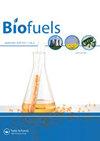Application of passion fruit seed meal in alternative biodiesel purification process: study of glycerol adsorption mechanism and incorporation into polymeric membrane
IF 2.6
4区 工程技术
Q3 ENERGY & FUELS
引用次数: 0
Abstract
Abstract The search for renewable energy sources is a global concern that strengthens the expansion of the biodiesel industry. In view of the environmental and economic problems of the conventional purification process of this biofuel, there is a need to explore alternative methods of purification. In this way, this manuscript evaluated the use of passion fruit seed meal as an alternative for biodiesel purification. In the adsorption tests, with a concentration of the biosorbent equal to 40 g L−1, at 45 °C, for 90 min, there was a removal of 72.2% of free glycerol and reduction in the content of glycerol to values below the maximum limit imposed by the legislation. Furthermore, through the characterization of the meal and the adsorption equilibrium data, it was possible to propose the mechanism involved in the adsorption process corresponds to hydrogen interactions between the glycerol and the oxygenated groups of the biosorbent. In the membrane separation process, the free glycerol removals obtained with the meal functionalized membrane were three times higher than those with the commercial membrane. Thus, the passion fruit seed meal can be a promising alternative for biodiesel purification, bringing economic and environmental advantages due to the reduction in the generation of effluents. GRAPHICAL ABSTRACT百香果籽粕在生物柴油替代纯化工艺中的应用:甘油吸附机理及在聚合物膜中的掺入研究
摘要寻找可再生能源是全球关注的问题,这加强了生物柴油行业的扩张。鉴于这种生物燃料的传统纯化过程的环境和经济问题,有必要探索替代的纯化方法。通过这种方式,本文评估了百香果籽粕作为生物柴油纯化替代品的用途。在吸附测试中,生物吸附剂的浓度等于40 g L−1,在45 °C,90 分钟,去除了72.2%的游离甘油,并将甘油含量降低到低于立法规定的最大限度的值。此外,通过对膳食的表征和吸附平衡数据,可以提出吸附过程中涉及的机制对应于甘油和生物吸附剂的含氧基团之间的氢相互作用。在膜分离过程中,用膳食功能化膜获得的游离甘油去除率是商业膜的三倍。因此,百香果籽粕是一种很有前途的生物柴油净化替代品,由于减少了废水的产生,带来了经济和环境优势。图形摘要
本文章由计算机程序翻译,如有差异,请以英文原文为准。
求助全文
约1分钟内获得全文
求助全文
来源期刊

Biofuels-Uk
Energy-Renewable Energy, Sustainability and the Environment
CiteScore
5.40
自引率
9.50%
发文量
56
期刊介绍:
Current energy systems need a vast transformation to meet the key demands of the 21st century: reduced environmental impact, economic viability and efficiency. An essential part of this energy revolution is bioenergy.
The movement towards widespread implementation of first generation biofuels is still in its infancy, requiring continued evaluation and improvement to be fully realised. Problems with current bioenergy strategies, for example competition over land use for food crops, do not yet have satisfactory solutions. The second generation of biofuels, based around cellulosic ethanol, are now in development and are opening up new possibilities for future energy generation. Recent advances in genetics have pioneered research into designer fuels and sources such as algae have been revealed as untapped bioenergy resources.
As global energy requirements change and grow, it is crucial that all aspects of the bioenergy production process are streamlined and improved, from the design of more efficient biorefineries to research into biohydrogen as an energy carrier. Current energy infrastructures need to be adapted and changed to fulfil the promises of biomass for power generation.
Biofuels provides a forum for all stakeholders in the bioenergy sector, featuring review articles, original research, commentaries, news, research and development spotlights, interviews with key opinion leaders and much more, with a view to establishing an international community of bioenergy communication.
As biofuel research continues at an unprecedented rate, the development of new feedstocks and improvements in bioenergy production processes provide the key to the transformation of biomass into a global energy resource. With the twin threats of climate change and depleted fossil fuel reserves looming, it is vitally important that research communities are mobilized to fully realize the potential of bioenergy.
 求助内容:
求助内容: 应助结果提醒方式:
应助结果提醒方式:


